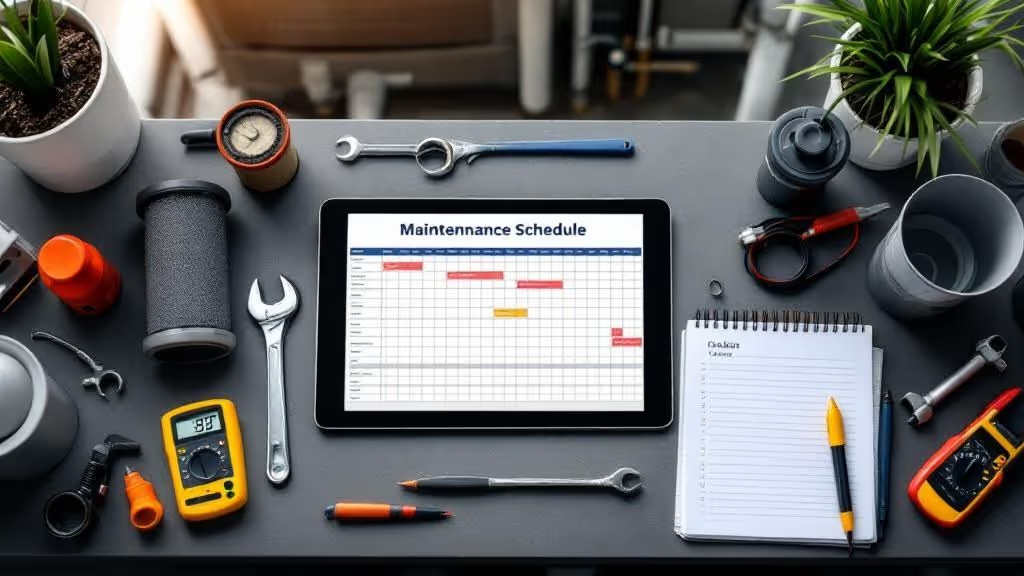When we talk about improving workplace communication, what we’re really talking about is creating a system where information gets where it needs to go, no questions asked. A setup like that can boost productivity by a staggering 25%. It's about making sure everyone has the right info at the right time, which cuts down on costly mistakes and, frankly, just makes for a better team.
Why Better Communication Is Your Best Investment
In any business that relies on both field crews and office staff, the gap between a clear instruction and a costly misunderstanding can make or break a project. Good communication isn’t just some fluffy soft skill; it's a hard-nosed operational tool that directly impacts your bottom line. When you build a culture around clear, consistent dialogue, you’re not just talking—you’re boosting productivity, improving morale, and creating a more resilient team.

This is more important now than ever. As teams become more spread out, the need for solid communication channels becomes painfully obvious. Think about it: participation in global teams shot up from 64% in 2010 to 89% by 2018. And while 64% of leaders agree that good communication drives results, a full third of professional communicators aren't happy with the tools they have. That’s a huge disconnect.
From Theory to Tangible Returns
Let's move past the abstract and look at what this means on the ground. Imagine a field technician spots an unexpected issue on a job site. Instead of a garbled phone call, they send a quick photo and a voice note directly to the office. The office team sees exactly what's happening and can react instantly.
This simple act prevents a dozen headaches. Delays are avoided. The wrong parts aren't ordered. The final invoice is accurate. That’s the real-world impact.
To get there, you need to lay some groundwork by establishing solid internal communication best practices. This isn't complicated; it just requires a bit of thought.
- Establish Clear Channels: Decide where communication happens. Is it a dedicated app? A specific WhatsApp group? Getting this straight prevents vital info from getting lost in a sea of texts, emails, and voicemails.
- Set Expectations: Be clear about things like expected response times and what information is non-negotiable for daily updates. No more guessing games.
- Choose Intuitive Tools: The technology should fit how your team already works. If it feels like a chore to use, they won't use it. Simple as that.
Investing in a streamlined communication process pays for itself. It reduces rework, speeds up billing cycles, and frees up your team to focus on their actual jobs instead of chasing down information.
Ultimately, shoring up your communication is about building a system founded on trust and efficiency. When your field and office teams are in sync, the whole operation runs like a well-oiled machine, your customers are happier, and your business is set up for real, sustainable growth.
5. Bridge the Gap Between Your Office and Field Teams
Let's be honest: the biggest communication breakdowns often happen right where the office's detailed plans collide with the messy reality of the field. This gap between the administrative team and your crews on the ground can cause serious friction. I've seen it lead to frustrating project delays, blown budgets, and even an "us vs. them" attitude that poisons company culture.
So, how do you fix it? You need to build a solid bridge. This means establishing a single, go-to channel where information flows effortlessly both ways.
When a technician runs into an unexpected problem on-site, they can’t afford to navigate a clunky reporting system. They need a direct line to the office, right then and there. By the same token, your office team needs to push out schedule changes or urgent client updates instantly, knowing the message will be received and understood without getting lost.
A common roadblock is the technology itself. Field crews need tools that are fast, simple, and work on their phones. Office staff, on the other hand, need organized, detailed records for critical tasks like invoicing, scheduling, and project management. This is where a tool your team already knows and uses every day—like WhatsApp—can be a game-changer when adapted for business workflows.
Create a Single, Unified Workflow
Instead of juggling scattered text messages, emails, and after-hours phone calls, a unified workflow ensures every important detail is captured and easy to find. Imagine a technician sending a quick photo and voice note about a broken part straight to a dedicated company number. No more chasing down information.
It’s not just about sending messages back and forth. It’s about creating a documented, verifiable record. When you centralize communication this way, the "he said, she said" arguments vanish, accountability becomes crystal clear, and genuine trust starts to build between the office and the field.
This is the kind of simple, professional WhatsApp interface that can become the backbone of your entire communication system.

The real magic is in using a platform everyone is comfortable with to introduce a more structured process, all without a painful learning curve for your crew.
Ultimately, this approach creates a single source of truth. The office gets the clean, actionable data they need for billing and planning, while the field team gets the immediate answers and support they need to do their job well. Everyone is finally working from the same playbook, fostering a cohesive environment where every single person, whether in a truck or at a desk, feels like they're on the same team.
Choosing Technology That Actually Helps
Let's be honest: technology is supposed to make our lives easier, but a lot of the time it just creates another headache. When it comes to bridging the communication gap between your office and field crews, picking the right tool is everything. It needs to fit into how your team already works, not force them to learn a complex new system from scratch.
This is especially true for your guys in the field. If an app is a pain to log into or has a clunky interface, they just won't use it. You’ll be right back where you started, with massive communication black holes. This is why we've seen so much success when businesses adapt familiar tools like WhatsApp for their workflows. Everyone already knows how to use it, so there's virtually no learning curve.
From there, you can build straightforward, repeatable processes. Think daily check-ins, snapping a quick photo of a broken part to send back to the office, or sharing progress updates. The technician in the field gets a quick win, and the office team gets an instant, crystal-clear view of what's happening on site.
Aligning Tools with Team Needs
The trick is to match the tool to the specific needs of your people. The explosion of remote and hybrid work means we're all drowning in digital tools. Some numbers really paint the picture here: 72% of the workweek is now spent communicating, and while 74% of companies rolled out new tools to cope, 70% of employees still feel communication is a struggle. This data, highlighted in a recent analysis of workplace communication trends, shows a huge disconnect. We have tools, but they aren't always the right ones.
To get it right, you have to think about what each team genuinely needs to do their job well.
- Field Teams Need: Something fast, simple, and mobile-first. They need to fire off information quickly without getting bogged down.
- Office Teams Need: Structure, detail, and the ability to easily find past conversations for things like invoicing, project planning, or customer disputes.
The image below gives a great visual of how different communication styles, often dictated by the tools we use, affect performance.

As you can see, while formal feedback might lead to slightly higher satisfaction, informal methods are far faster and happen more often. For fast-paced field operations, that speed is absolutely critical.
My biggest takeaway from years of experience? Choosing the right tool isn’t about ticking off a list of features. A simple tool that everyone actually uses every single day is infinitely more valuable than a powerful, expensive platform that nobody ever logs into.
When you find a system that truly serves both your office staff and your field crew, you're not just buying software. You're creating a smooth, efficient flow of information that cuts down on frustration and gets more work done.
Comparing Communication Tool Types
To help you decide what might work best, I've put together a quick comparison of the most common platforms. There's no single "best" option—it all comes down to your team's specific context and challenges.
Ultimately, the best tool is the one that removes friction, not adds it. Consider how your teams communicate now and look for a solution that enhances those existing habits.
Crafting Clear and Actionable Messages
Great communication isn't just about relaying information. It's about making sure your message lands, is understood, and gets acted on correctly—the first time. The single biggest communication breakdown I see between the office and the field is ambiguity. A fuzzy request from a dispatcher almost always leads to a frustrated tech, wasted hours, and sometimes, costly rework.
The fix starts with bringing absolute clarity to every message you send. Before you hit send on a task, take a moment to run it through the “5 Ws”. It's a simple mental checklist that forces you to be specific and leaves very little room for things to go sideways.
Use the 5 Ws for Total Clarity
This old-school journalistic framework is gold for assigning work or sharing critical updates. It turns a simple message into a complete, self-contained package of information.
- Who: Who, specifically, is this task for? Name the person directly.
- What: What is the exact task? No jargon, just plain language.
- When: What’s the deadline? Give a real time, like "by 4 PM today," not a vague "ASAP."
- Where: Where does this need to happen? A full address or specific site location is a must.
- Why: Why are we doing this? A little context goes a long way. It helps your crew understand the bigger picture and solve problems on their own.
Think about the difference. A message like, "Hey, can someone check on the Johnson site?" is a recipe for confusion.
Now, let's try it with the 5 Ws: "John, please head to 123 Main St. to inspect the faulty HVAC unit before noon. The client needs a quote by the end of the day so we can order parts tomorrow." See the difference? One is a guess, the other is a plan.
A study found that 30% of employees feel frustrated by unclear communication from their managers. Taking an extra 30 seconds to frame your message properly can save hours of back-and-forth and genuinely improve your team's morale.
Once you've sent the assignment, the job's not quite done. You need to confirm your message was received and understood. Ditch the generic, "Does that make sense?"
Instead, try asking something open-ended, like, “What’s your first step going to be?” This simple switch confirms they’ve processed the instructions and are already thinking about execution. You’re not micromanaging; you’re making sure they're set up for success.
Building a Culture of Open Feedback
Let's be honest, top-down directives just don't cut it. Real communication flows both ways. For that to happen, you have to build an environment of what experts call psychological safety—a space where every single person on your team, especially the folks out in the field, feels safe enough to speak up. They need to know they can ask questions, point out a problem, or offer an idea without getting shut down or facing backlash.
When people feel heard, they stop just following orders and start actively solving problems.

This kind of change has to start at the top. When managers and leaders actively ask for input, listen carefully, and then actually do something with that information, they set the standard. It’s not about waiting for the annual performance review; it’s about weaving feedback into the fabric of your daily work.
Make Feedback a Regular Habit
Trust isn't built in a day. It comes from consistent, regular check-ins—both formal and informal. A quick message asking, "How's the site looking today?" can be just as important as a scheduled monthly meeting. Consistency is everything.
I’ve found that a two-pronged approach works best:
- Quick, Informal Touchpoints: A dedicated WhatsApp group or a similar tool is perfect for this. It gives field crews a simple way to flag small issues on the spot before they snowball into massive headaches.
- Dedicated Feedback Sessions: You still need to set aside dedicated time for deeper conversations. This gives everyone a forum to discuss bigger ideas, ongoing frustrations, and long-term improvements without feeling rushed.
The most important part? You have to be receptive to what you hear. Your field teams are your eyes and ears on the ground. They have insights into processes, equipment, and client sites that office staff could never get. Their feedback isn't just helpful; it’s gold.
When you truly listen to feedback from the field, you're doing more than just fixing a problem. You're showing your team that their experience and expertise matter. That simple act of respect is one of the most powerful things you can do for morale and retention.
The data backs this up. One study found that 88% of employees who feel they're kept in the loop are happy with their jobs. But there’s a catch: non-desk workers often feel left out, reporting much lower satisfaction with the information they get. Even where managers get high marks for communication, there's always room to improve. If you want to dive deeper, you can learn more about these employee communication findings and see how they connect directly to job satisfaction.
Got Questions About Communication? We've Got Answers.
Even with the best game plan, improving how your teams talk to each other can feel like trying to hit a moving target. I've seen countless leaders and crews run into the same walls when trying to bridge the gap between the office and the field. Let's dig into some of those frequent questions with real-world advice you can actually use.
The biggest mistake I see is thinking this is just about sending messages back and forth. It’s not. It's about building a reliable system that works for everyone—from the seasoned foreman who hates new tech to the detail-oriented coordinator back at the office. The sweet spot is finding something that’s dead simple for the field but gives the office the structure they need.
"How Do I Get My Crew to Actually Use a New Tool?"
This is probably the number one question I get. Getting less tech-savvy folks on board with new software can feel impossible. The secret? Make it frictionless. Choose a tool that doesn’t feel like a tool at all. Something they already know and use in their personal lives, like WhatsApp, completely removes that initial "I don't know how to use this" barrier.
Then, you have to sell the benefit. Don't talk about "synergy" or "efficiency." Frame it around their daily headaches. Show them exactly how this new way of doing things means no more garbled voicemails, lost notes, or waiting on hold for a simple answer.
Here’s what works in practice:
- Keep training short and sweet. A quick, hands-on demo is worth a hundred pages in a manual.
- Create a one-page "cheat sheet." Just show them the 3-4 most important things they'll do every day.
- Start with a small pilot group. Find a few of your more respected crew members and get them using it first. When others see them getting quicker answers and leaving the job site on time, they'll want in.
Here's a pro tip from my own experience: Don't make it feel like a corporate mandate. Position it as an upgrade designed to make their lives easier. If they see their buddies finishing jobs with fewer headaches, natural curiosity and a desire for less stress will do the work for you.
"How Do We Know if Our Communication Is Actually Getting Better?"
If you can't measure it, you can't manage it. To really know if your efforts are paying off, you need to look at both the hard data and the human feedback. Relying on just one gives you a skewed picture.
First, look at the quantitative metrics—the cold, hard facts. Are you seeing fewer project mistakes or a drop in missed deadlines? Have on-site incidents or safety issues gone down? A 20% reduction in rework orders, for instance, is a massive sign that the right information is getting to the right people at the right time.
But numbers don't tell the whole story. You also need qualitative metrics to understand how your team feels. I’m a big fan of short, regular pulse surveys. Ask simple, direct questions like:
- "On a scale of 1-5, how clear were your instructions this week?"
- "Do you feel you have what you need from the office to do your job well?"
When you start seeing team members proactively offering solutions instead of just pointing out problems, that’s another huge win. It means they feel heard and are invested in making things work.
Ready to put these communication challenges behind you for good? See how Nora, ResQ’s AI assistant, uses the simplicity of WhatsApp to create clean, actionable job notes from your field team’s updates. Book your demo today.



